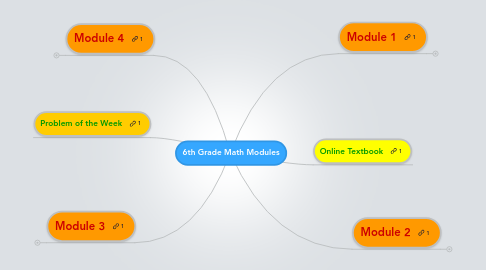
1. Module 1
1.1. Unit 1
1.1.1. Dividing Whole Numbers
1.1.2. Prime Factorization
1.1.3. Greatest Common Factor
1.1.4. Least Common Multiple
1.1.5. Adding and Subtracting Fractions
1.1.6. Adding and Subtracting Mixed Numbers
1.1.7. Renaming When Subtracting Mixed Numbers
1.1.8. Multiplying Fractions/Mixed Numbers
1.1.9. Dividing Fractions/Mixed Numbers
1.1.10. Order of Operations
1.1.11. Order of Operations with Fractions
1.1.12. Fraction Story Problems
1.1.13. Study Guide
1.2. Unit 2
1.2.1. Adding Decimals
1.2.2. Subtracting Decimals
1.2.3. Multiplying Decimals
1.2.4. Dividing Decimals
1.2.5. Decimal Word Problems
1.2.6. Study Guide
1.3. Unit 3
1.3.1. Decimals and Fractions
1.3.2. Decimals and Percents
1.3.3. Fractions and Percents
1.3.4. Fractions, Decimals, and Percents
1.3.5. Concepts of Ratios
1.3.6. Equivalent Ratios
1.3.7. Graphing Ratios
1.3.8. Solving Equivalent Ratios
1.3.9. Unit Rates
1.3.10. Unit Rate Story Problems
1.3.11. Study Guide
2. Module 2
2.1. Unit 1
2.1.1. Proportional Relationships
2.1.2. Solving Proportions
2.1.3. Proportion Story Problems
2.1.4. Scale Drawings
2.1.5. Graphing Proportions
2.1.6. Making Predictions
2.1.7. Study Guide
2.2. Unit 2
2.2.1. Expressions and Exponents
2.2.2. Square Roots
2.2.3. Evaluating Algebraic Expressions
2.2.4. Writing Algebraic Expressions
2.2.5. Distributive Property
2.2.6. Combining Like Terms
2.2.7. Review of Combining Like Terms
2.2.8. Study Guide
2.3. Unit 3
2.3.1. Subtraction One-Step Equations
2.3.2. Addition One-Step Equations
2.3.3. Multiplication One-Step Equations
2.3.4. Division One-Step Equations
2.3.5. One-Step Equation Story Problems
2.3.6. Dependent and Independent Variables
2.3.7. Solving Two-Step Equations
2.3.8. One- and Two-Step Equations
2.3.9. Two-Step Equation Story Problems
2.3.10. Study Guide
3. Module 3
3.1. Unit 1
3.1.1. Classifying Triangles
3.1.2. Classifying Quadrilaterals
3.1.3. Interior Angles of Triangles and Quadrilaterals
3.1.4. Interior Angles of Regular Polygons
3.1.5. Similar and Congruent Figures
3.1.6. Transformations and Symmetry
3.1.7. Study Guide
3.2. Unit 2
3.2.1. Perimeter and Circumference of Circles
3.2.2. Area of Parallelograms
3.2.3. Area of Triangles and Trapezoids
3.2.4. Review Area of Triangles and Trapezoids
3.2.5. Area of Circles
3.2.6. Area of Complex Figures
3.2.7. Review Area of Complex Figures
3.2.8. 3-D Shapes
3.2.9. Volume of Prisms and Cylinders
3.2.10. Study Guide
3.3. Unit 3
3.3.1. Plotting and Ordering Integers
3.3.2. Opposites and Absolute Value
3.3.3. Review of Opposites and Absolute Value
3.3.4. Comparing Integers
3.3.5. Coordinate Plane
3.3.6. Review of Coordinate Plane
3.3.7. Scientific Notation
3.3.8. Customary System
3.3.9. Metric System
3.3.10. Review of Metric and Customary System
3.3.11. Study Guide
4. Module 4
4.1. Unit 1
4.1.1. Patterns and Sequences
4.1.2. Distributive Property and Factoring
4.1.3. Multiplying Variables
4.1.4. Review of Like Terms and Distributive Property
4.1.5. Conversions of Time and Temperature
4.1.6. Study Guide
4.2. Unit 2
4.2.1. Frequency Tables, Stem-and-Leaf Plots, and Line Plots
4.2.2. Measures of Central Tendency
4.2.3. Bar Graphs and Histograms
4.2.4. Circle Graphs
4.2.5. Box-and-Whisker Plots
4.2.6. Line Graphs
4.2.7. Appropriate Data Displays
4.2.8. Population and Samples
4.2.9. Scatter Plots
4.2.10. Misleading Graphs
4.2.11. Study Guide
4.3. Unit 3
4.3.1. Probability
4.3.2. Experimental Probability
4.3.3. Sample Spaces
4.3.4. Theoretical Probability
4.3.5. Making Predictions
4.3.6. Independent and Dependent Events
4.3.7. Combinations
4.3.8. Permutations
4.3.9. Study Guide
